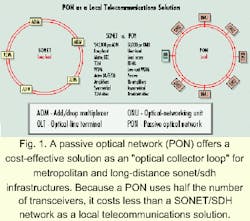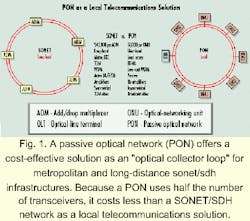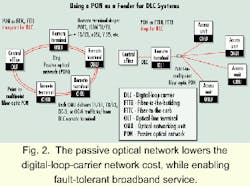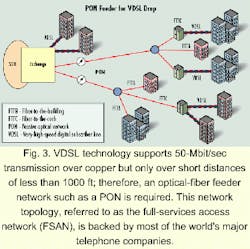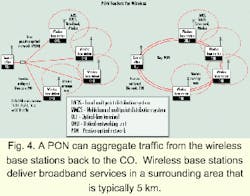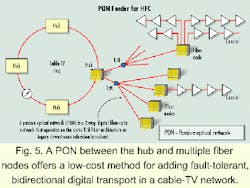PONs for the broadband local loop
Something old and something new, passive-optical-network technology is the optical feeder of choice for existing access infrastructures.
| In this article |
|---|
| What is PON technology? |
| Feeder for DLC systems |
| Feeder for xDSL |
| Feeder for wireless |
| Feeder for HFC |
| PON as FTTX |
| Outlook |
As the battle between digital subscriber line (DSL), cable modem, and broadband wireless delivery grabs most of the headlines, a new technology is emerging that will improve performance and extend the reach of all these systems. Passive-optical-network (PON) technology is the optical feeder of choice for copper (DSL), coaxial (hybrid fiber/coax-HFC), and wireless (local multipoint distribution system-LMDS) because it offers the lowest-cost, point-to-multipoint transport solution.
A PON is an optical-access architecture that facilitates broadband (voice, data, and video) communications between an optical line terminal (OLT) and multiple remote optical network units (ONUs) over a purely passive optical distribution network. By definition, a PON has no active elements in the network path that require optical-to-electrical conversions. Instead, PON systems use passive fiber-optic couplers or splitters to optically route traffic. In contrast, an active optical network (AON) such as a Synchronous Optical Network/Synchronous Digital Hierarchy (SONET/SDH) infrastructure requires optical-to-electrical-to-optical conversion at each node. The PON can aggregate traffic from up to 32 ONUs back to the central office (CO) using a tree, bus, or fault-tolerant ring architecture.
Like SONET/SDH, PON is a layer 1 transport technology. Until recently, most telecommunications fiber rings used SONET/SDH transport equipment. These rings-using regeneration at each node-are optimized for long-haul and metropolitan infrastructures, but are not the best choice for the local-access network.
A PON offers a cost-effective solution as an "optical collector loop" for metropolitan and long-distance SONET/SDH infrastructures. A PON has a lower initial cost because deployment of the fiber is required up front. ONUs can then be added to the PON incrementally as demand for services arises, whereas active networks require installation of all nodes up front because each node is a regenerator.
To further reduce costs, a wavelength-division multiplexing (WDM) layer can be added to a PON because the nodes sit "off" the backbone. When employing WDM on an SONET/SDH ring, demultiplexing and remultiplexing is required to bypass each node.
A PON is also a cost-effective way to broadcast video because it is a downstream point-to-multipoint architecture. The broadcast video, either analog or digital, is added to the time-division multiplexing (TDM) or the WDM layer of the PON.
Unlike SONET/SDH, a PON can also be asymmetrical. For example, a PON can broadcast OC-12 [622 Mbits/sec] downstream and access OC-3 [155 Mbits/sec] upstream. An asymmetrical local loop allows for lower-cost ONUs, which use less expensive transceivers. SONET/SDH, however, is symmetrical. Thus, in an OC-12 SONET/SDH ring, all line cards must have an OC-12 interface.
For local-loop applications, a PON can be more fault-tolerant than SONET/SDH. The PON node resides off the network, so that loss of power to a node does not affect any other node. This is not true for SONET/SDH, where each node performs regeneration. The ability of a node to lose power without network disruption is important in the local loop, because telephone companies cannot guarantee power backup to each remote terminal.For these reasons, PON technology is the most likely transport candidate for the local telephone network (see Fig. 1). In a sense, PON technology does not compete with SONET/SDH because it can use SONET/SDH-compatible interfaces and serve as the short-haul "optical collector loop" for both metropolitan and long-haul SONET/SDH rings.
PONs can serve as a feeder to extend fiber from the local exchange to the neighborhood or curb, where copper, coaxial, or wireless systems provide the last-mile connections to subscribers. One of the most promising applications for a PON is as a feeder for digital loop-carrier (DLC) systems. DLC systems multiplex voice and data channels over copper or fiber to remote terminals that distribute services to subscribers.
Typically, DLC systems have been used to reduce copper-cable deployments and extend "plain old telephone service" (POTS) to remote subscribers. Recently, DLC vendors introduced integrated access platforms that carry voice, data, and video traffic. These systems respond to the growing demand for broadband capabilities from telephone companies and enable a variety of services, including POTS, Integrated Services Digital Network (ISDN), DSL, and digital carrier services such as T1/E1 (1.544 Mbits/sec, 2.048 Mbits/sec).
In rural areas, this new generation of DLC products will help extend broadband services to remote subscribers. In urban settings, these DLC systems will improve network efficiency by expanding the bandwidth of existing copper and fiber facilities. This means that integrated access DLC systems could become the preferred solution for telephone companies that want to simplify their central office (CO) and provide broadband services over shorter drops of twisted-pair copper.As DLC systems evolve toward a broadband architecture, new deployments will require fiber-to-the-curb (FTTC) or fiber-to-the-building (FTTB) solutions. One alternative is to multiplex traffic to and from remote terminals or integrated access units using a low-cost, high-bandwidth PON. Using a PON as a feeder for DLC systems can significantly lower the cost and improve the performance of DLC deployment. As shown in Figure 2, a PON can be used between the CO and the remote terminal to provide FTTC or FTTB. It can also be used between the remote terminal and the customer terminal equipment to provide FTTB or fiber-to-the-home (FTTH).
PONs offer a number of benefits over traditional feeder solutions for DLC systems:
- Using a point-to-multipoint ring architecture dramatically reduces the cost of the outside plant by minimizing the amount of fiber cable required. Because the cost of deploying fiber can be more than $5 per foot, using a point-to-multipoint topology can save more than $1 million compared to a network with point-to-point links.
- The PON's point-to-multipoint architecture broadcasts signals from the OLT at the CO downstream to every ONU. This makes it an appealing solution for telephone companies that plan to introduce cable TV.
- A PON can deliver a POTS channel for less than $10. While the DLC remote terminal still requires a POTS line card, the additional cost of a point-to-multipoint network is small. If the DLC multiplexer and OLT are merged as one box, then a PON becomes the lowest-cost narrowband DLC transport solution. When broadband is considered, PON technology easily wins the cost war.
- Because a PON features a point-to-multipoint architecture with typically 32 or fewer nodes, low-cost WDM solutions can be used to deliver dedicated high-speed data to each ONU. Using a WDM overlay, a PON is capable of any OC-N speed. This allows the service provider to carry high-speed leased lines and gives competitive local-exchange carriers (CLECs) the ability to lease a high-speed access path.
- As a point-to-point link, a traditional DLC system is subject to cable failure. When using a fault-tolerant PON ring, a DLC system is fully fault tolerant.
In response to competition and growing demand for broadband services, telephone companies are attempting to leverage their existing copper infrastructure through deployment of xDSL technologies. Very-high-speed DSL (VDSL) technology will allow for up to 50-Mbit/sec transmission. It can only provide this bandwidth, however, over twisted copper pairs of less than 1000 ft. Thus, only a very small percentage of subscribers can benefit from this technology.
To overcome this distance/bandwidth problem, xDSL systems will eventually be deployed with a fiber-optic feeder network. With this in mind, major telephone companies are backing an initiative to develop standards for a broadband local loop called full-services access network (FSAN, see "FSAN initiative propels broadband access worldwide," page 60). FSAN advocates a network architecture using a shared PON with dedicated VDSL drops. By extending a fiber feeder to within 3000 ft of subscribers, telephone companies can provide 25-Mbit/sec broadband service-including video-over the "drop" of twisted-pair copper into the subscriber's premises.This architecture makes sense, as it is more economical to replace a feeder cable from the CO than it is to rip up the thousands of individual twisted copper pairs running through people's backyards. A PON feeder to a VDSL drop is expected to be the least-expensive upgrade for copper-heavy telecommunications infrastructures, and it allows these providers to also offer video services (see Fig. 3).
Broadband wireless systems facilitate rapid local-loop deployment using technologies that will deliver megabit-per-second service. Several broadband wireless technologies are now available, including LMDS, a multichannel multipoint distribution system (MMDS), and digital microwave. These systems typically consist of a single hub or CO linked to multiple base stations that deliver services to buildings or residences.Broadband wireless systems require line-of-sight access, operate over limited distances, and are subject to attenuation from rain. Given these limitations, a critical issue facing wireless operators is how to aggregate traffic from multiple base stations back to the CO. One alternative is to interconnect base stations and the CO using a low-cost, high-bandwidth PON (see Fig. 4).
Narrowband wireless technology is also a cost-effective solution for "greenfield" deployments in developing countries with limited telecommunications infrastructures. For example, in India, where telephone penetration is approximately one set per 100 people, low-cost solutions will be needed to reach the goal of extending POTS and Internet access. According to Ashok Jhunjhunwala, a professor at the Indian Institute of Technology, installation costs must fall to less than $250 per subscriber in order to reach 20% penetration. In his paper "Affordable Fiber Access Network for Developing Countries," Professor Jhunjhunwala shows that a PON feeder combined with wireless or copper drops to subscribers provides the lowest-cost, high-bandwidth solution for voice and data services in emerging economies.
Cable operators also face the need to upgrade their networks to introduce interactive broadband services. To date, the cable network uses an analog coaxial bus that can broadcast large amounts of bandwidth. However, it is a unidirectional medium with high maintenance and coaxial amplifier costs.
To address these limitations, many cable TV operators have adopted an HFC architecture with optical fiber penetrating deep into the network. HFC implementations replace part of the coaxial access network by running fiber-optic cable from the cable-TV headend to the distribution nodes. The broadcast signal is translated into an electrical analog signal that is transmitted to the subscriber via a coaxial connection. The primary shortcoming of this approach is its inability to provide fault-tolerant, symmetric, bidirectional service, which is required for truly interactive broadband applications.To address this problem, cable-TV operators can deploy a low-cost PON between the headend station and fiber nodes. Like the cable-TV network, a PON is a downstream broadcast architecture, so it distributes video downstream from a single hub to multiple fiber nodes, along with bidirectional voice and data traffic (see Fig. 5).
A PON can serve as the feeder for broadband copper, wireless, and coaxial drops-but it can also be used for the "home run." A PON can support a fiber-to-the-X (FTTX) architecture; the "X" is where the ONU resides-at the curb, neighborhood, building, or home. Because FTTH in mass deployment is years away, PON technology will initially be used in FTTC and FTTB architectures. These architectures are usually hybrid networks with PON technology serving as the low-cost, high-bandwidth feeder; traditional copper and coaxial cable are used as the customer device interface.
When a PON is deployed as an FTTB system, an ONU located in a building's telecommunications closet can provide full broadband services to all occupants. In this type of an optical collector loop, the PON can use standard SONET/SDH rates and WDM interfaces.
A PON can provide any type of service, including voice, data, and video. Like SONET/SDH, it is a transport network, but one that is designed for the cost-sensitive local loop. What makes PON so attractive is that while it can enable DLC systems, DSL, HFC, and wireless to reach broadband capacity, it is not a new access solution. In that sense, the PON does not replace copper, coaxial, and wireless embedded networks, but allows these traditional infrastructures to be used in shorter, higher-bandwidth drops.
PON technology promises to break the bandwidth bottleneck, leading to a local-access network that is digital, broadband, and interactive. In the short-term, the most promising application for PON technology is as an optical feeder for telephone companies, cable-TV operators, and wireless service providers. It complements emerging broadband access technologies such as xDSL, HFC, and LMDS, rather than competing against them, by allowing for shorter access drops and higher bandwidth. Because it provides a low-cost, high-bandwidth, fault-tolerant solution for carriers interested in delivering revenue- generating broadband services, PON technology offers the best solution for the next-generation, broadband local loop.
Gerry Pesavento is president and Mark Kelsey is director of business development at Alloptic Inc. (Davis, CA). Gerry can be reached at [email protected].
